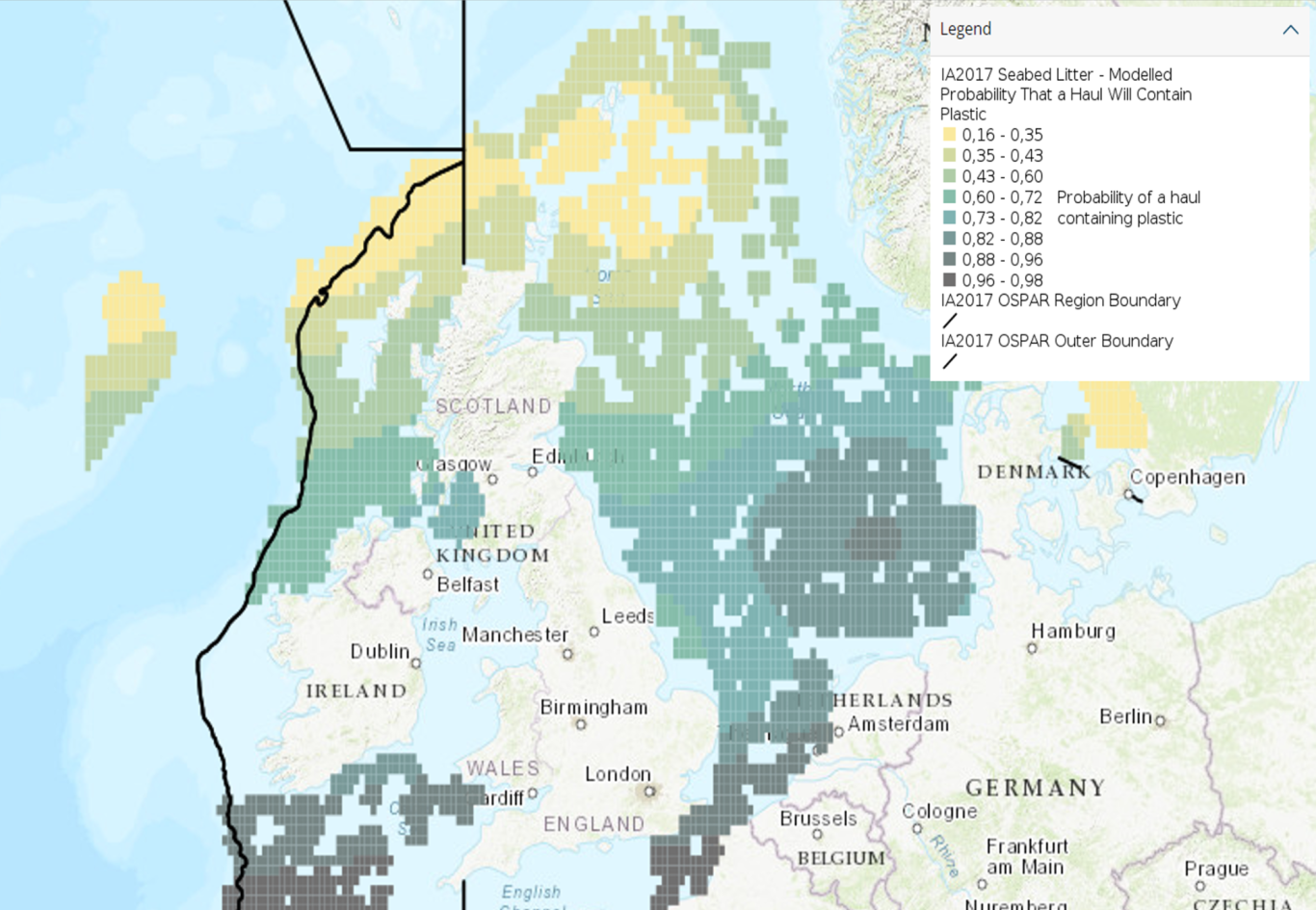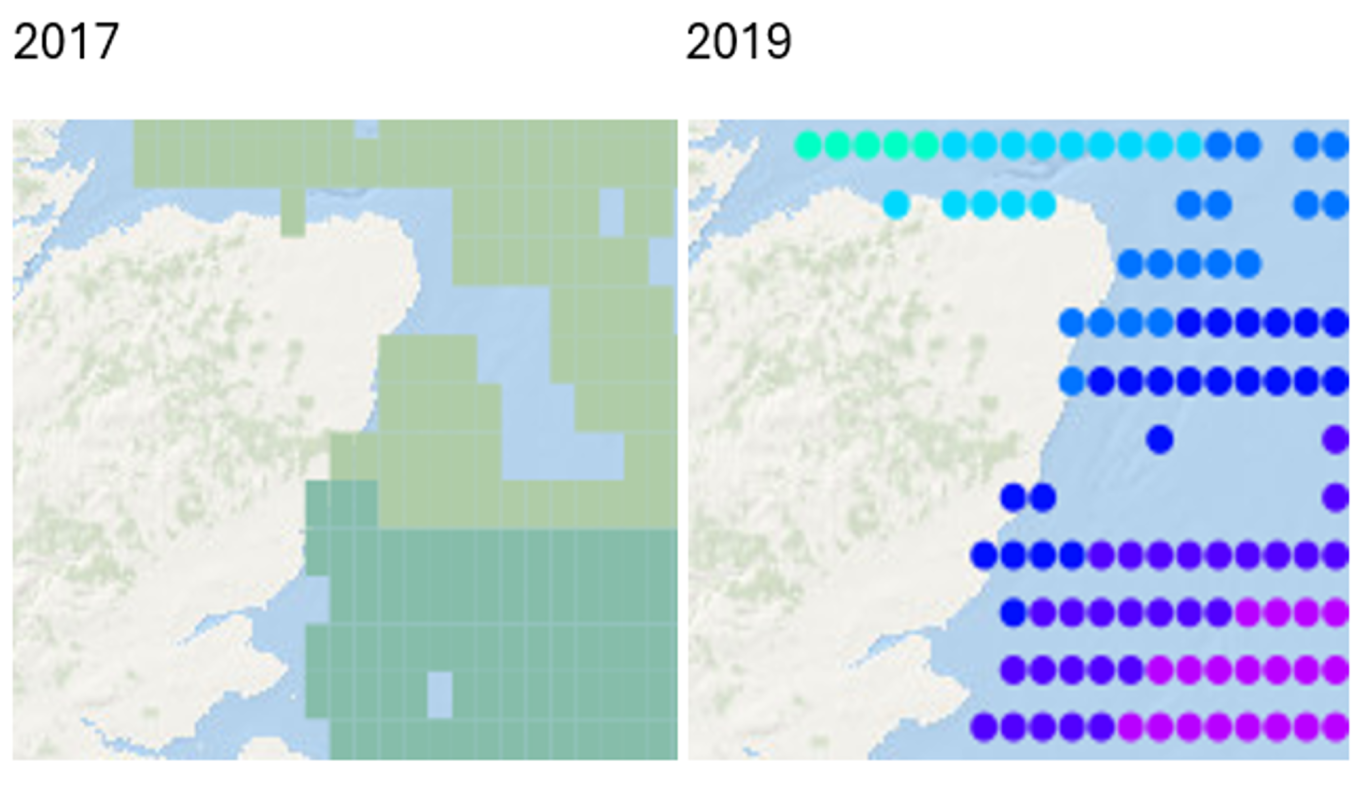Recent East Grampian Beach Litter Trends (2021 - 2023)
Key Findings
Seabed litter is an important component of marine litter, consisting of denser pieces that are more likely to sink than float to shore (OSPAR, 2022). Due to the shallow nature of the continental shelf around Europe, it acts as a sink for collecting such litter. This litter can be harmful to marine life via entanglement (link to ALDFG page), ingestion, introduction of invasive species and damage to habitat. (Barry et al, 2022)
OSPAR collects data on seafloor litter levels through benthic trawl surveys. The results are quantified as the “probability that a haul will contain a litter item” (Barry et al, 2022), with 0 being 0% chance of finding litter, and 1 being a 100% guarantee of finding litter. OSPAR maps from 2017 (fig. 1) and 2019 (fig, 2) are shown below, visualising this probability measure in terms of plastic. They clearly show a lower probability of plastic within a haul in the North and West, and a much higher probability in the South and East.
In their 2022 seafloor litter review OSPAR conclude that of all regions surveyed, the Bay of Biscay in France contained the most litter, with an 87% chance of a haul containing litter. The Greater North Sea averaged a 69% chance, and the Celtic Seas a 45% chance. The Greater North Sea increased in the likelihood of hauls containing litter between 2012 and 2019, rising from 60 – 70%. OSPAR find this to be the only region surveyed to increase in this measure (fig. 3 for regions). Averaged over all regions, plastic was the most common litter material identified, while fishing industry debris closely followed. (Barry et al, 2022)
Along the East Grampian Coast specifically, the 2019 data shows the probability of a haul containing plastic to range from 53.1% - 68% (fig. 4), a score in the upper-middle range of results. In 2017, the area scored between 43-72% (fig. 4) but mostly lay in the 43-60% range, suggesting perhaps a small increase in seabed plastic between the years.
Benthic trawl surveys are primarily used for fish stock assessments; wherein large nets are dragged across the seafloor to catch marine life. There are quite a few limitations with this method when researching seabed litter, as the nets are designed for sea creatures, not pieces of rubbish. As such, heavier types of litter like glass or metals may slip through the netting, leaving lighter plastic-type litter falsely inflated in the final numbers. Additionally, there is difficulty sampling rocky seabed or reefs, so generally only areas of soft seabed are represented. Despite these limitations, overall, these surveys offer valuable, large scale and long-term data sets. (Barry et al, 2022)

figure 1: 2017 Distribution of Seafloor Litter - Probability That a Haul Will Contain Plastic

figure 2: 2019 Distribution of Seafloor Litter - Probability That a Haul Will Contain Plastic

fig. 3: OSPAR Regions .

fig. 3: East Grampian Focus: Magnified comparison of figs. 1 & 2
Notes
None
Linked Information Sheets
Beachwatch Results Turning The Plastic Tide (Tonnage) Bathing Water Quality Fishing Gear Turning The Plastic Tide (Volunteers Numbers) Turning The Plastic Tide (School Engagement) Nurdle Hunt Results East Grampian Beach Litter Trends 21-23
Key sources of Information
Reviewed on/by
Status
Live. Next update due 22/11/25
To report errors, highlight new data, or discuss alternative interpretations, please complete the form below and we will aim to respond to you within 28 days
Contact us
Telephone: 07971149117
E-mail: ian.hay@stateofthecoast.scot
We need your consent to load the translations
We use a third-party service to translate the website content that may collect data about your activity. Please review the details in the privacy policy and accept the service to view the translations.

